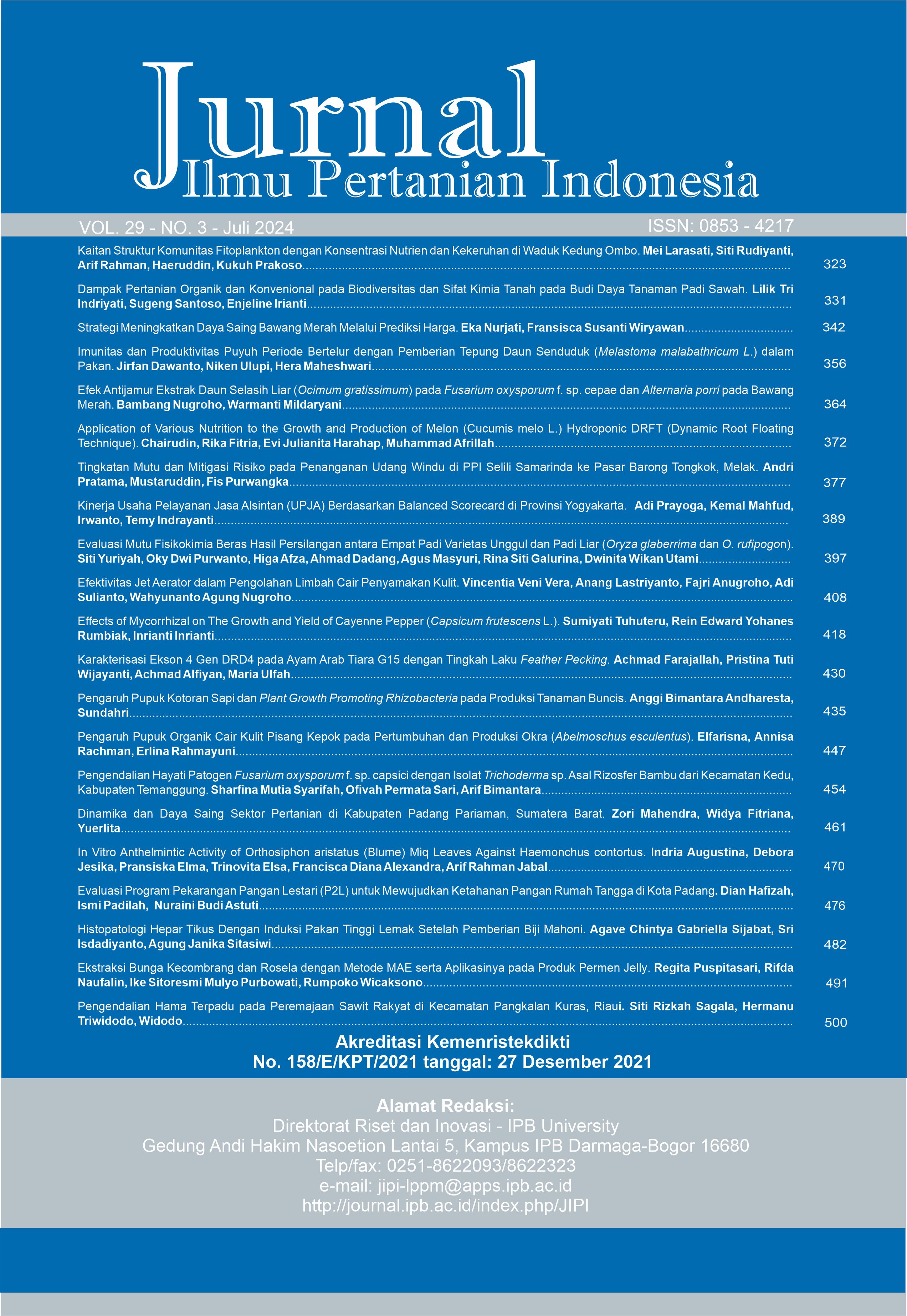Evaluasi Program Pekarangan Pangan Lestari (P2L) untuk Mewujudkan Ketahanan Pangan Rumah Tangga di Kota Padang
Abstract
The purposes of research are to describe the implementation of the Sustainable Food Crop Program and evaluate the activities of the Sustainable Food Crop Program in Padang City. This research method used a quantitative descriptive method with a survey research type. The samples taken were 36 people from 9 KWTs. Data were collected using a questionnaire. The results of the research show that the implementation of the Sustainable Food Yard Program (P2L) in Padang City has been conducted well in accordance with the Technical Instructions for Implementing the P2L program in 2022. For the second objective, it was evaluated using four variables, namely target accuracy, program socialization, program objectives, and program monitoring. The research results were displayed in the form of scores and it was found that the total percentage score for all variables was 94.79%. The target accuracy variable obtained a score of 37.69 with a score percentage of 94%. The program socialization variable obtained a score of 37.75 with a score percentage of 94%. The program objective variable obtained a score of 36.22 with a score percentage of 91% and the program monitoring variable obtained a score of 16.00 with a percentage of 100%. It can be concluded that the Food Yard Program (P2L) in Padang City has been conducted effectively.
Keywords: budikdamber, effectiveness, food security, sustainable food crop (P2L)
Downloads
References
Amalia BR, Mardatillah, Saputra J, Kurniawati SE, Adhar, Bafadal R, Faradillah N, Hardianti BRA, An-Nabhani N, Bima, Safhira D, Wardhani V, Antara WC, Handayana IGNY. 2022. Pengenalan Program Pekarangan Pangan Lestari (P2L) sebagai Solusi Pemenuhan Pangan Keluarga Kepada Anak Sekolah Dasar di Desa Jeruk Manis, Kecamatan Sikur, Lombok Timur. Jurnal Pengabdian Magister Pendidikan IPA 4(3):p.49–53. https://doi.org/10.29303/jpmpi.v4i3.1942
Azizah BOP, Soedarto T, Parsudi S. 2022. Pemanfaatan Lahan Pekarangan dan Peran Kelompok Wanita Tani Melalui Program Pekarangan Pangan Lestari di Kota Malang. Jurnal Ilmiah Mahasiswa Agroinfo Galuh 9(3): 956–970. https://doi.org/10.25157/jimag.v9i3.7905
Budiani NW. 2007. Efektivitas Program Penanggulangan Pengganguran. Jurnal Ekonomi dan Sosial. 2(1): 49–57.
Dwi Tama R, Priyanti E. 2022. Efektivitas Program Pekarangan Pangan Lestari (P2l) Dalam Upaya Ketahanan Pangan Keluarga di Desa Pasirkaliki Kabupaten Karawang Tahun 2021. Jurnal Ilmiah Wahana Pendidikan 2022(20): 282–289.
Dwiratna S, Widyasanti A, Rahmah DM. 2017. Pemanfaatan Lahan Pekarangan Dengan Menerapkan Konsep Kawasan Rumah Pangan Lestari. Dharmakarya 5(1): 19–22.
Matesih K, Karanganyar K, Safrudin Musthofa M, Permatasari P. 2023. Jurnal Komunikasi dan Penyuluhan Pertanian Journal of Communication and Agricultural Extension Keberhasilan Program Pekarangan Pangan Lestari (P2L) Melalui Evaluasi Model Context, Input, Process dan Product (CIPP) di The Success of the Sustainable Food Ya. Jurnal Kirana. 4(1): 45–64.
Musdalifah M, Baruwadi MH, Moonti A. 2023. Dampak Program Pekarangan Pangan Lestari (P2L) Pada Peningkatan Pendapatan Rumah Tangga Petani Padi Sawah Di Desa Bulota Kecamatan Telaga Jaya Kabupaten Gorontalo. AGRINESIA: Jurnal Ilmiah Agribisnis 7(1): 35–45.
Salsabhilah HP. 2019. Upaya Pengembangan Program Kawasan Rumah Pangan Lestari Pada Dinas Ketahanan Pangan Kota Samarinda. eJounal Ilmu Pemerintahan 7(4): 1733–1742.
Saputri EM, Wibowo A, Rusdiyana E. 2021. Dampak Implementasi Program Pekarangan Pangan Lestari (P2L) Di Kecamatan Gondangrejo Kabupaten Karanganyar. Agrica Ekstensia 15(2): 125–131.
Sugiono. 2016. Metode Penelitian Kuantitatif, Kualitatif dan R&D,
Sukmawani R, Astutiningsih ET, Ramadanti L. 2022. Dampak Program Pekarangan Pangan Lestari (P2L) Terhadap Tingkat Kecukupan Gizi (TKG). Paspalum: Jurnal Ilmiah Pertanian 10(2): 225–230.
Copyright (c) 2024 Dian Hafizah, Dian Hafizah

This work is licensed under a Creative Commons Attribution-NonCommercial 4.0 International License.
This journal is published under the terms of the Creative Commons Attribution-NonCommercial 4.0 International License. Authors who publish with this journal agree to the following terms: Authors retain copyright and grant the journal right of first publication with the work simultaneously licensed under a Creative Commons Attribution-NonCommercial 4.0 International License. Attribution — You must give appropriate credit, provide a link to the license, and indicate if changes were made. You may do so in any reasonable manner, but not in any way that suggests the licensor endorses you or your use. NonCommercial — You may not use the material for commercial purposes.























